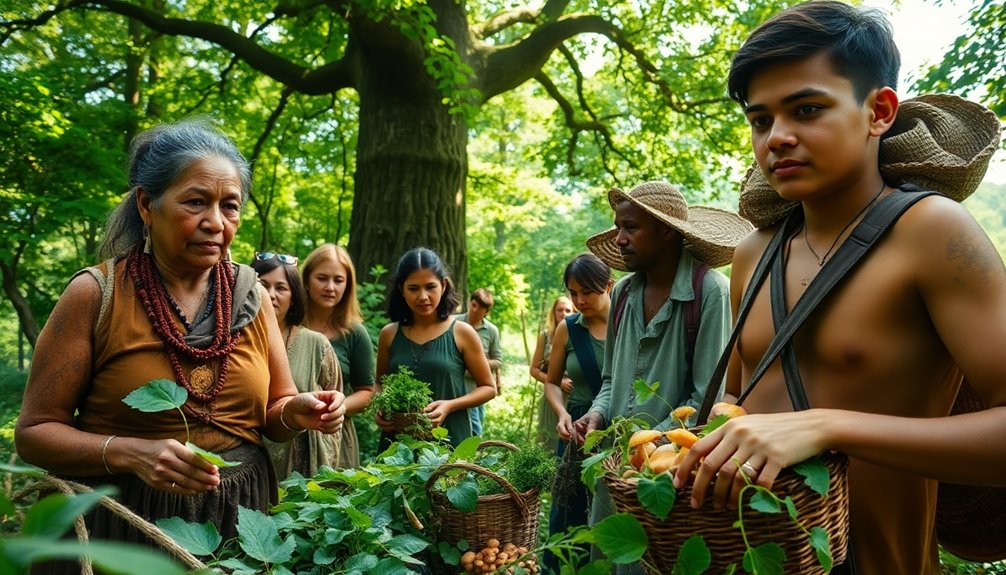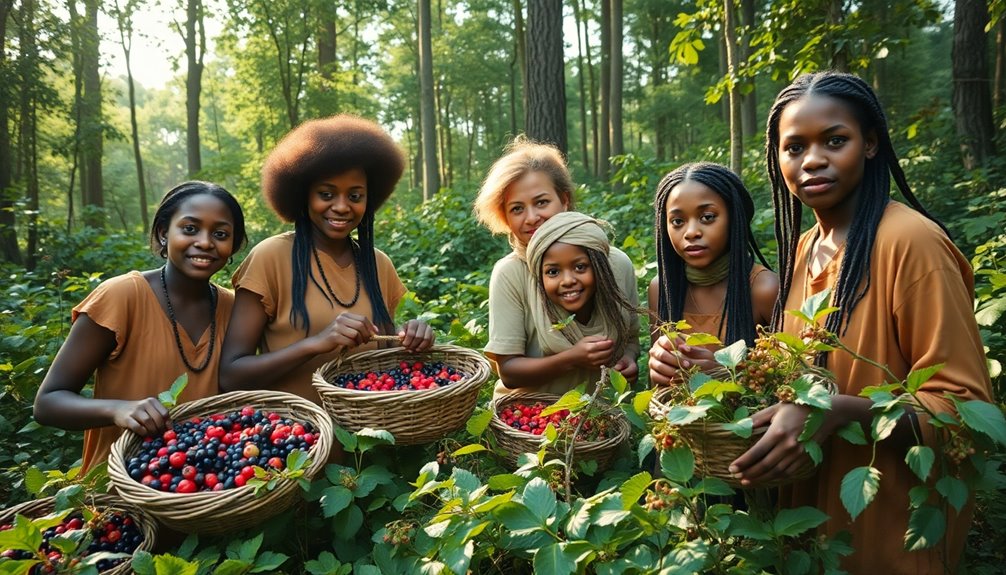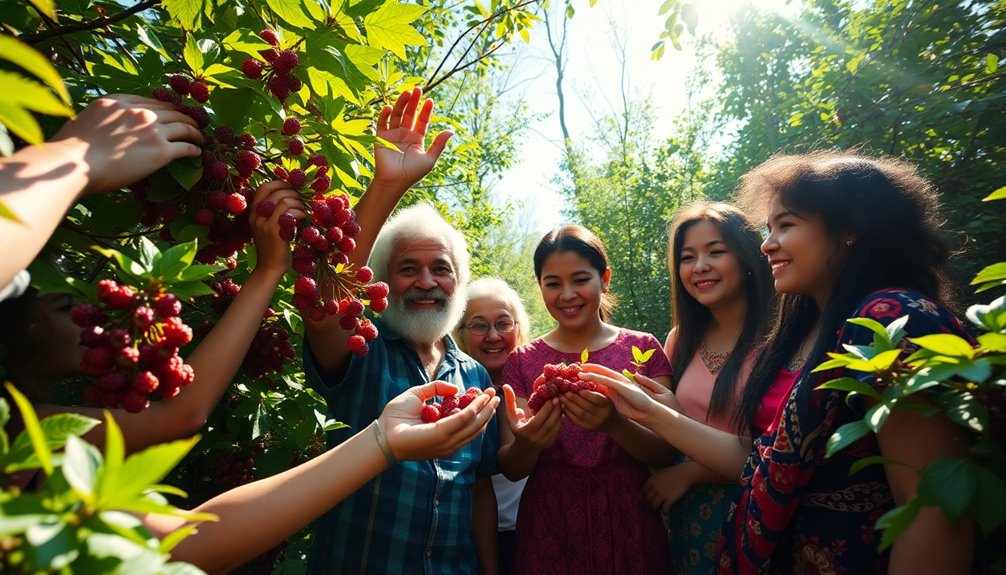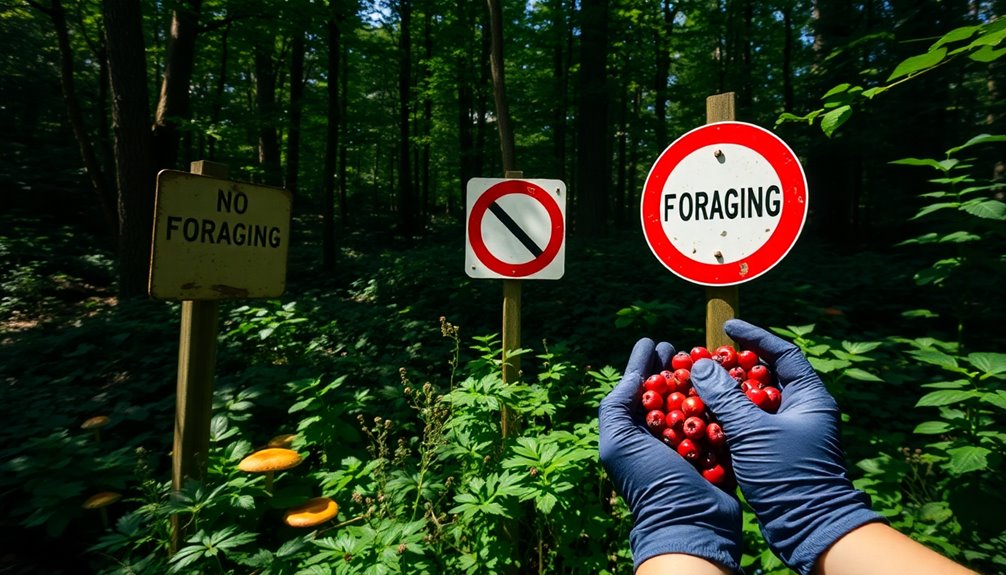Foraging societies often seem egalitarian at first glance, but the truth is more complex. While they prioritize cooperation and resource sharing, hidden inequalities exist. Social status can emerge based on kinship, age, or personal relationships, creating a subtle hierarchy. Gender roles also play a significant part, with men's hunting often viewed as more prestigious, overshadowing women's essential contributions. Even within communal settings, disparities in resource access can arise, leading to imbalances. So, if you think you've got the full picture, you're just scratching the surface of these intriguing social dynamics and their real implications.
Key Takeaways
- Foraging societies generally exhibit egalitarian structures, minimizing hierarchy and emphasizing cooperation among community members for survival.
- Resource sharing within these societies promotes social equity, although disparities can arise from charismatic leaders or resource hoarding.
- Gender roles are present, with men focusing on hunting and women on gathering, yet both contribute significantly to food supply and community well-being.
- Informal conflict resolution mechanisms foster social harmony, allowing for quick resolutions and maintaining communal relationships despite occasional disputes.
- Closer proximity to market economies can exacerbate inequalities, shifting gender dynamics and challenging traditional egalitarian principles of foraging communities.
Defining Foraging Societies

Foraging societies, often described as hunter-gatherer groups, thrive on the dual principles of mobility and resourcefulness. These small, mobile communities usually consist of a few hundred individuals who rely on hunting, gathering, and fishing for sustenance.
You'll find that their social organization typically features egalitarian social structures, minimizing hierarchy and emphasizing cooperation and sharing among members. This setup is essential for survival, as it fosters a sense of collective responsibility.
In these societies, individual autonomy is a key feature. Members make personal decisions about resource use, balancing their needs with the welfare of the group. Cultural practices further reinforce communal living, often leading to social norms that discourage the accumulation of personal wealth. Instead, everyone shares what they have, which strengthens bonds and promotes equality.
Ethnographic evidence from various foraging groups highlights their diverse adaptations to environmental challenges. This resilience and flexibility not only demonstrate their survival skills but also showcase the effectiveness of their egalitarian principles.
The Myth of Egalitarianism

You might think foraging societies are entirely egalitarian, but that's not the whole story.
Research shows that inequalities often arise, especially concerning resource access and social roles, including gender dynamics.
This complexity challenges the idea that all foraging communities operate under the same principles of equality.
Actual Inequalities in Foraging
How do we reconcile the idea of egalitarianism in foraging societies with the reality of actual inequalities? While many believe these societies operate on equal footing, evidence suggests otherwise. Factors like access to resources and individual skill levels introduce disparities that challenge the egalitarian narrative.
| Aspect | Inequalities |
|---|---|
| Access to Resources | Some individuals hoard or control resources, creating disparities. |
| Social Status | Charismatic leaders can amass wealth, overshadowing peers. |
| Gender Roles | Hunting is often seen as more prestigious than women's work, leading to imbalances. |
In many foraging communities, hunting success can vary widely, leading to unequal food distributions. Even though communal sharing is a norm, the dynamics of gift-giving can reinforce hierarchies. You might see that the power of the state, even in its absence, can manifest through influence and social capital, showing that foraging societies aren't as egalitarian as they seem. Consequently, while they may endeavor for equality, actual inequalities persist, affecting social dynamics and relationships within these groups.
Gender Roles and Status
In many foraging societies, the prevalent notion of egalitarianism often masks significant gender roles and status differences. While you might think of these communities as equal, you'll find that gender roles create a division of labor, with men focusing on hunting and women primarily engaged in gathering and childcare.
Even in societies like the Ju/hoansi San, where men and women contribute equally to food gathering, distinct roles persist, highlighting an underlying gender stratification.
These gender stereotypes can mislead you into believing that women are weaker or less capable, despite their essential contributions to subsistence and community well-being. The domestic-public dichotomy further complicates this issue, as women's roles are often confined to the private sphere, limiting their status and recognition compared to men's public roles.
Moreover, proximity to market economies can exacerbate these inequalities, with men often gaining higher status and economic power through market interactions.
This dynamic challenges the idea of true egalitarianism in foraging societies, revealing that while men and women may work together, significant status disparities still exist based on gender roles.
Social Dynamics in Foraging Groups

Foraging societies thrive on a unique set of social dynamics that prioritize egalitarianism and cooperation among their members. These small, mobile groups often exhibit minimal hierarchy, fostering an environment where individual autonomy is valued. You're encouraged to make personal decisions regarding resource allocation while balancing the needs of the community. This balance guarantees resilience and adaptability in the face of changing conditions.
Conflicts may arise from competing autonomous decisions, but foragers develop social mechanisms to mediate disputes and maintain group harmony. Ethnographic studies reveal diverse expressions of autonomy across different foraging groups, showcasing varying social dynamics.
Here's a simple breakdown of the key aspects of social dynamics in foraging societies:
| Aspect | Description | Importance |
|---|---|---|
| Autonomy | Freedom in personal decision-making | Fosters individual expression |
| Egalitarianism | Minimal hierarchy and shared resources | Promotes cooperation |
| Resource Allocation | Collective management of resources | Supports community well-being |
Gender Roles and Equality

In foraging societies, gender roles are more fluid than you might expect, with both men and women playing vital roles in subsistence.
You'll find that women's contributions, particularly in gathering and child-rearing, are often on par with men's hunting efforts.
However, as these societies come closer to market economies, you may see shifts that elevate men's status and disrupt this balance.
Gender Roles Overview
Gender roles in food-foraging societies often reflect a surprising level of equality, where both men and women contribute considerably to survival. In these cultures, men typically engage in hunting while women focus on gathering, yet both roles are equally essential. Foragers like the Ju/hoansi San exemplify this balance, as men and women spend roughly the same amount of time on food gathering activities.
You'll find that gender stratification is minimal in many foraging societies. Resource distribution and decision-making processes tend to be communal, rather than hierarchical, fostering a sense of shared responsibility. This egalitarian approach extends to child-rearing practices, too. For instance, breastfeeding can delay ovulation, allowing women to actively participate in food gathering alongside men during significant periods.
Moreover, the domestic-public dichotomy illustrates how roles may shift depending on context, but it's clear that the contributions of both genders are recognized and valued. This equality in gender roles not only supports survival but also strengthens community bonds, showcasing the rich social fabric of foraging societies.
Fundamentally, you can see how these dynamics challenge traditional views on gender roles and highlight the egalitarian nature of these communities.
Women's Contributions Highlighted
Women in foraging societies play a significant role in sustaining their communities, often providing the majority of the food through gathering efforts. Their contributions are indispensable, typically accounting for around 60-80% of the diet in many hunter-gatherer groups. This considerable input challenges traditional views of gender roles, illustrating a more egalitarian structure among foragers.
Here are three key aspects of women's contributions:
- Food Gathering: Women often spend equal time as men on gathering activities, ensuring a diverse and stable food supply that supports the community's nutritional needs.
- Social Cohesion: Their roles extend beyond food provision; women's contributions foster social networks and community bonds, reinforcing collaboration and mutual support.
- Kinship and Alliances: Women enhance their status through kinship ties and marriage, playing a significant part in alliance-building, which is essential for social dynamics in foraging societies.
These factors demonstrate that women's contributions aren't only essential for survival but also for maintaining the egalitarian nature of foraging communities. Their active participation reshapes perceptions of gender roles and emphasizes the importance of inclusivity in these societies.
Impact of Market Proximity
Market proximity greatly influences gender roles and equality in foraging societies. When communities are closer to markets, you'll often notice an increase in gender stratification. Men typically gain higher status in these economic activities, which can undermine the value of women's contributions, such as gathering and childcare.
As market dynamics enter the picture, women's roles may shift towards domestic responsibilities, limiting their economic participation and perceived equality.
Research on the Ju/hoansi San illustrates this trend; as market proximity increases, overlapping gender roles diminish. This leads to differentiated access to resources and social status, reinforcing traditional hierarchies.
In contrast, foraging communities that remain isolated tend to maintain egalitarian structures, where men and women share responsibilities and status more equally.
The introduction of markets can exacerbate existing inequalities, pushing women into more constrained roles and impacting their involvement in economic activities.
Consequently, you can see how market proximity shapes not only gender roles but also the overall dynamics of equality in foraging societies, ultimately challenging the notion of egalitarianism in these contexts.
Leadership Structures in Bands

In foraging societies, leadership structures are often informal and arise situationally, allowing individuals to step into roles of influence based on the group's consensus.
You'll notice that leaders, often called headmen, rely on persuasion and social influence rather than formal authority to guide decisions. This fosters a more egalitarian environment where kinship ties play an essential role in leadership dynamics.
Here are three key aspects of leadership in band societies:
- Consensus-Based Leadership: Leaders emerge based on the group's agreement, ensuring that their influence is widely accepted.
- Status from Kinship and Experience: Leadership is typically influenced by age and gender, with older members often respected for their wisdom and experience.
- Community Obligations: The "big man" concept highlights how leadership can stem from personal relationships and social responsibilities, rather than inherited titles.
These structures promote cooperation and collective decision-making, reinforcing the egalitarian nature of foraging societies.
You can see how kinship and communal ties create a dynamic environment where leadership is fluid and adaptable, ultimately benefiting the entire group.
Conflict Resolution Mechanisms

Conflict resolution in foraging societies often unfolds like a dance, where community members engage in informal discussions to mend rifts and restore harmony. In these band societies, mediators emerge organically from the group, facilitating conversations centered on consensus rather than formal rules. Unique cultural practices, like song duels or humor, enrich these interactions, emphasizing the importance of community cohesion.
| Method | Description |
|---|---|
| Informal Discussions | Community members talk to resolve issues |
| Cultural Practices | Use of humor or songs to diffuse tension |
| Social Mechanisms | Gossip and collective decision-making reinforce ties |
Conflicts are typically resolved quickly, as prolonged disputes threaten the limited resources of foragers. This collaborative approach highlights a shared priority: social harmony and community welfare. Ethnographic evidence shows that individuals often set aside personal grievances to nurture group solidarity, reinforcing the idea that community cohesion is essential for survival in these societies. By embracing these informal conflict resolution methods, foragers cultivate an environment where relationships flourish, ultimately strengthening their communities.
Implications for Modern Societies

Foraging societies' egalitarian structures offer valuable lessons for modern communities endeavoring for social equity and resource distribution.
By examining their practices, you can uncover strategies that promote fairness and cooperation. Here are three key implications for modern societies:
1. Resource Sharing: Emphasizing the importance of sharing resources can help alleviate inequalities, ensuring everyone has access to essentials.
This approach fosters a sense of community resilience, as individuals work together for mutual benefit.
2. Balancing Autonomy and Welfare: Foraging societies highlight the balance between individual autonomy and group welfare.
By respecting personal freedoms while promoting collective well-being, modern communities can create a supportive environment that nurtures both personal growth and social equity.
3. Conflict Resolution: The social mechanisms used by foraging societies to mediate conflicts can inspire contemporary approaches to resolving disputes.
Implementing cooperative strategies can help address tensions and foster stronger community ties.
Frequently Asked Questions
Are Foraging Societies Egalitarian?
When you look at foraging societies, you might think they're inherently egalitarian due to their small, mobile groups and emphasis on sharing.
Many of these societies promote cooperation and individual autonomy, which helps balance wealth and resources among members.
However, you'll find that inequality can still emerge based on resource access and social dynamics.
Are Hunter-Gatherer Societies Egalitarian?
You might think hunter-gatherer societies are purely egalitarian, but the truth is a bit more complex.
While many of these groups promote sharing and cooperation, significant inequalities can still exist. Factors like age, gender, and individual skills can create disparities in status and resources.
For instance, the Ju/hoansi San demonstrate overlapping gender roles, challenging stereotypes.
What Is One Reason That Food Foraging Societies Are Egalitarian?
One reason food foraging societies are egalitarian is their emphasis on communal resource sharing.
You'll find that members of these small, mobile groups often rely on each other for survival, which fosters a culture of cooperation.
This shared responsibility minimizes hierarchy, as everyone contributes to gathering food and resources.
Plus, the absence of significant material wealth helps diminish status differences, leading to a more balanced power dynamic among individuals.
Is an Important Hallmark of Foraging Societies Is Their Egalitarian Social Structure?
Imagine a circle where everyone shares equally, like kids trading snacks at lunch. That's what you'll find in foraging societies.
Their social structure emphasizes equality, where decisions are made collectively, and roles are fluid. You see men and women working side by side, reinforcing balance.
The lack of formal leaders means power shifts based on consensus, promoting autonomy while fostering cooperation.
This shared approach creates a harmonious community, rooted in egalitarian values.
Conclusion
In exploring foraging societies, you uncover complexities that challenge the notion of true egalitarianism. While some aspects promote equality, others reveal hierarchies, gender dynamics, and leadership roles that shape social interactions. Understanding these nuances enriches your perspective on human behavior. By examining social structures, conflict resolution, and the interplay of roles, you see how foraging societies reflect both collaboration and competition, reminding you that equality isn't always straightforward, even in the simplest of communities.










